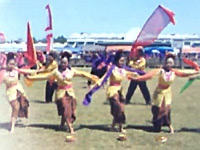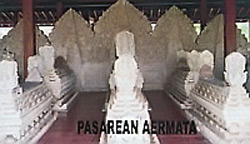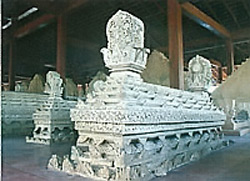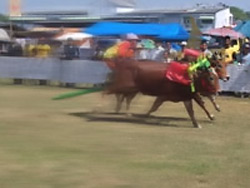Populations of Yogyakarta
 Based on 2000, the total population of Yogyakarta special Region amounted to 3.311.812. Yogyakarta Municipality that has 461,800 inhabitants spread over 32,50 kilometers or the average population density is thus over 14,200 persons per square kilometer. The least densely populated districts is in Gunung Kidul regency which has 720.643 inhabitants and cover 1,485 square kilometers or the density rate is 485 persons per square kilometer. Since a very long time ago the Provincial territory of Yogyakarta Special Region and its surrounding has been decently populated.
Based on 2000, the total population of Yogyakarta special Region amounted to 3.311.812. Yogyakarta Municipality that has 461,800 inhabitants spread over 32,50 kilometers or the average population density is thus over 14,200 persons per square kilometer. The least densely populated districts is in Gunung Kidul regency which has 720.643 inhabitants and cover 1,485 square kilometers or the density rate is 485 persons per square kilometer. Since a very long time ago the Provincial territory of Yogyakarta Special Region and its surrounding has been decently populated.
The majority residents of Yogyakarta Special Region are Javanese whose language derives from ancient Sanskrit. However, as Yogyakarta is considered to be "Indonesia's academic city" due to the numerous centers for higher learning, many of the inhabitants are student who come from all over Indonesia to study.
Culture of Yogyakarta
 The culture Yogyakarta province with its status as a special region lies in the Southern part of Central Java, in the heartland of Javanese culture. As the former capital and the center of several kingdoms in the past, this region and its people are very rich in a variety of cultures. It is widely known from to historical records that the civilization, art and culture had developed well in the center of those kingdoms respectively in the Ancient Mataram Kingdom (8th - 10th Century) era, the second Mataram Kingdom (17th - 18th Century) and Sultanate Ngayogyokarto from the mid of 18th Century up today.
The culture Yogyakarta province with its status as a special region lies in the Southern part of Central Java, in the heartland of Javanese culture. As the former capital and the center of several kingdoms in the past, this region and its people are very rich in a variety of cultures. It is widely known from to historical records that the civilization, art and culture had developed well in the center of those kingdoms respectively in the Ancient Mataram Kingdom (8th - 10th Century) era, the second Mataram Kingdom (17th - 18th Century) and Sultanate Ngayogyokarto from the mid of 18th Century up today.
 It should be noted that the cultural heritage from the past includes the magnificent temples, the ruins of palaces and monasteries, the various kind of traditions, cultural events, traditional folk and performing arts, architecture and other traditional activities. It is important to note that this is all part of the living culture of Yogyakarta, color of daily activities of live and the local inhabitants behavior, particularly the Javanese community with its traditional way of life and customs. Therefore, because of its culture richness and heritage, Yogyakarta has long been known as the cradle of Javanese culture.
It should be noted that the cultural heritage from the past includes the magnificent temples, the ruins of palaces and monasteries, the various kind of traditions, cultural events, traditional folk and performing arts, architecture and other traditional activities. It is important to note that this is all part of the living culture of Yogyakarta, color of daily activities of live and the local inhabitants behavior, particularly the Javanese community with its traditional way of life and customs. Therefore, because of its culture richness and heritage, Yogyakarta has long been known as the cradle of Javanese culture.
 The other legendary name for Yogyakarta City, among the elders as well as the youth generation that is the City of Art and Culture. Traditional and modern exhibition are held almost every day and night about the art of theater, pantomime, music, classic and contemporary dances, poems, etc. Those are flow in the heart of the city. Even more, there are abundant of cultural ceremony, such as Sekaten, Gunungan, Labuhan, Malioboro Fair, etc, which make the city has high value of tradition, art, and culture.
The other legendary name for Yogyakarta City, among the elders as well as the youth generation that is the City of Art and Culture. Traditional and modern exhibition are held almost every day and night about the art of theater, pantomime, music, classic and contemporary dances, poems, etc. Those are flow in the heart of the city. Even more, there are abundant of cultural ceremony, such as Sekaten, Gunungan, Labuhan, Malioboro Fair, etc, which make the city has high value of tradition, art, and culture.

Yogyakarta Special Region (Daerah Istimewa Yogyakarta, DIY) is officially one of Indonesia's 32 provinces. Yogyakarta is one of the foremost cultural centers of Java. This region is located at the foot of the active Merapi volcano, Yogyakarta was in the 16th and 17th centuries the seat of the mighty Javanese empire of Mataram from which present day Yogyakarta has the best inherited of traditions. The city itself has a special charm, which seldom fails to captivate the visitor.
This province is one of the most densely populated areas of Indonesia. The city came into being in 1755, after the Mataram division into the Sultanates of Yogyakarta and Surakarta (Solo). Gamelan, classical and contemporary Javanese dances, wayang kulit (leather puppet), theater and other expressions of traditional art will keep the visitor spellbound. Local craftsmen excel in arts such batiks, silver and leather works. Next to the traditional, contemporary art has found fertile soil in Yogya's culture oriented society. ASRI, the Academy of Fine Arts is the center of arts and Yogyakarta itself has given its name to an important school of modern painting in Indonesia, perhaps best personified by the famed Indonesian impressionist, the late Affandi.
Yogyakarta is often called the main gateway to the Central Java as where it is geographically located. It stretches from Mount Merapi to the Indian Ocean. There is daily air service to Yogya from Jakarta, Surabaya and Bali as well as regular train service and easy accessibility by road. Yogyakarta is commonly considered as the modern cultural of Central Java. Although some may prefer Solo as a good runner up, Yogyakarta remains the clear front-runner for traditional dance, Wayang (traditional puppetry) and music.
Yogyakarta has more than just culture though. It is a very lively city and a shopper's delight. The main road, Malioboro Street, is always crowded and famous for its night street food-culture and street vendors. Many tourist shops and cheap hotels are concentrated along this street or in the adjoining tourist area such Sosrowijayan Street.
The key attraction of Yogyakarta is 'Kraton' (the Sultan's Palace). The Sultan's palace is the centre of Yogya's traditional life and despite the advance of modernity; it still emanates the spirit of refinement, which has been the hallmark of Yogya's art for centuries. This vast complex of decaying buildings was built in the 18th century, and is actually a walled city within the city with luxurious pavilions and in which the current Sultan still resides. Yogyakarta is also the only major city, which still has traditional 'Becak' (rickshaw-style) transport. Geographically
Yogyakarta Special Region is geographically located almost equidistant from Indonesia's two most important international gateways, about 600 km from Jakarta and 1000 km from Bali. Yogyakarta also has excellent transport connections by bus, train or plane to the rest of Java, Sumatra, Bali and Lombok. Yogyakarta's Adisucipto Airport is in the process of changing its status in order to receive not only domestics' flights from Bali and Jakarta, but also direct charter and scheduled flights from other countries.
Geographically, Yogyakarta Special Province is situated in the Southern part of Central Java and lies between 7 degree 33' and 8 degree 12', South altitude between 110 degree and 50' East longitude. Some regencies of central Java Province surround the administrative boundaries of this region:
Southern East: Wonogiri Regency
Eastern: Klaten Regency
Northwestern: Magelang Regency
Western: Purworejo Regency
The Indonesian Ocean borders the Southern part of Yogyakarta. The borderline of the seashore stretches from West to East of which the length is around 100 km, started from Congot Beach in Kulon Progo Regency and ended at Sadeng Beach in Gunung Kidul Regency.
Because of its location, Yogyakarta is strategically positioned for the economic activity network in Java as well as for the tourist destination area. The special region of Yogyakarta lies midway on the axis of several main tourist destination areas, Jakarta and West Java westward, Central Java northward, East Java and Bali eastward. It is linked by regular rail, road and air services to other parts of Indonesian archipelago.Climate and Weather in Yogyakarta
The average daily temperature range between 26 degree and 28 degree Celsius with its minimum 18 degree C and maximum 35 degree C respectively. Average humidity is 74% with its minimum of 65% and maximum 84% respectively. The Yogyakarta Special Region lays approximately 7 South of the equator line and is bathed in tropical; sunshine along the year. This region has a tropic climate the daily atmosphere feels a little bit hot and humid. These are only two seasons along the year, the wet or rainy seasons and dry monsoon. Usually the wet seasons begin at September and lasts about August. Generally there is no rainfalls from may to August and there fore the atmosphere feels hot and humid on the day and cool in the night and early morning. The monthly rain falling Yogyakarta varies between 3mm and 496mm in which those above 300mm take place during the month of January up to April. The heaviest rainfall usually occurs in February while the lowest commonly happens between May and October Average annually rainfall is about 1,900mm.Populations of Yogyakarta
Based on 2000, the total population of Yogyakarta special Region amounted to 3.311.812. Yogyakarta Municipality that has 461,800 inhabitants spread over 32,50 kilometers or the average population density is thus over 14,200 persons per square kilometer. The least densely populated districts is in Gunung Kidul regency which has 720.643 inhabitants and cover 1,485 square kilometers or the density rate is 485 persons per square kilometer. Since a very long time ago the Provincial territory of Yogyakarta Special Region and its surrounding has been decently populated.
The majority residents of Yogyakarta Special Region are Javanese whose language derives from ancient Sanskrit. However, as Yogyakarta is considered to be "Indonesia's academic city" due to the numerous centers for higher learning, many of the inhabitants are student who come from all over Indonesia to study.
Culture of Yogyakarta
The culture Yogyakarta province with its status as a special region lies in the Southern part of Central Java, in the heartland of Javanese culture. As the former capital and the center of several kingdoms in the past, this region and its people are very rich in a variety of cultures. It is widely known from to historical records that the civilization, art and culture had developed well in the center of those kingdoms respectively in the Ancient Mataram Kingdom (8th - 10th Century) era, the second Mataram Kingdom (17th - 18th Century) and Sultanate Ngayogyokarto from the mid of 18th Century up today.
It should be noted that the cultural heritage from the past includes the magnificent temples, the ruins of palaces and monasteries, the various kind of traditions, cultural events, traditional folk and performing arts, architecture and other traditional activities. It is important to note that this is all part of the living culture of Yogyakarta, color of daily activities of live and the local inhabitants behavior, particularly the Javanese community with its traditional way of life and customs. Therefore, because of its culture richness and heritage, Yogyakarta has long been known as the cradle of Javanese culture.
The other legendary name for Yogyakarta City, among the elders as well as the youth generation that is the City of Art and Culture. Traditional and modern exhibition are held almost every day and night about the art of theater, pantomime, music, classic and contemporary dances, poems, etc. Those are flow in the heart of the city. Even more, there are abundant of cultural ceremony, such as Sekaten, Gunungan, Labuhan, Malioboro Fair, etc, which make the city has high value of tradition, art, and culture.
source byhttp://www.indonesia-tourism.com/yogyakarta/index.html












 The potency, which able to be enjoyed by the tourists in Aer Mata cemetery is the unique carving at the wall side in each dome, and grave warangka that so exquisite and artistic. In 1975, the carve arts in grave complex of Aer Mata get the artistic champion titled carved omission of ancient Asian selenium. It give in the artistic of carved Angkor World in Cambodia which known as one of 7 omission miracles (ancient) world. Carve dome wall and warangka made from alabaster to symbolize the association phonetic symbol and reconciliation between the believers in Madura at 16 to 18 century ago. The configuration of building architecture art was started from consecutive admission doorstep, fence circled, and 3 domes of grave of king. It is the ancient vision culture pledge. Building physical of this grave has done without using cement gluten, except brick heap with natural technique insulator.
The potency, which able to be enjoyed by the tourists in Aer Mata cemetery is the unique carving at the wall side in each dome, and grave warangka that so exquisite and artistic. In 1975, the carve arts in grave complex of Aer Mata get the artistic champion titled carved omission of ancient Asian selenium. It give in the artistic of carved Angkor World in Cambodia which known as one of 7 omission miracles (ancient) world. Carve dome wall and warangka made from alabaster to symbolize the association phonetic symbol and reconciliation between the believers in Madura at 16 to 18 century ago. The configuration of building architecture art was started from consecutive admission doorstep, fence circled, and 3 domes of grave of king. It is the ancient vision culture pledge. Building physical of this grave has done without using cement gluten, except brick heap with natural technique insulator.
 Pangelengan Hollow, is bank hollow in the hill wall of north side. It is nicely, this hollow is extent of granite rock / onyx, so that it is very fit for rest place, and enjoy the beautiful of natural lake and extent of wide rice field in foothills.
Pangelengan Hollow, is bank hollow in the hill wall of north side. It is nicely, this hollow is extent of granite rock / onyx, so that it is very fit for rest place, and enjoy the beautiful of natural lake and extent of wide rice field in foothills.


 Based on 2000, the total population of Yogyakarta special Region amounted to 3.311.812. Yogyakarta Municipality that has 461,800 inhabitants spread over 32,50 kilometers or the average population density is thus over 14,200 persons per square kilometer. The least densely populated districts is in Gunung Kidul regency which has 720.643 inhabitants and cover 1,485 square kilometers or the density rate is 485 persons per square kilometer. Since a very long time ago the Provincial territory of Yogyakarta Special Region and its surrounding has been decently populated.
Based on 2000, the total population of Yogyakarta special Region amounted to 3.311.812. Yogyakarta Municipality that has 461,800 inhabitants spread over 32,50 kilometers or the average population density is thus over 14,200 persons per square kilometer. The least densely populated districts is in Gunung Kidul regency which has 720.643 inhabitants and cover 1,485 square kilometers or the density rate is 485 persons per square kilometer. Since a very long time ago the Provincial territory of Yogyakarta Special Region and its surrounding has been decently populated. The culture Yogyakarta province with its status as a special region lies in the Southern part of Central Java, in the heartland of Javanese culture. As the former capital and the center of several kingdoms in the past, this region and its people are very rich in a variety of cultures. It is widely known from to historical records that the civilization, art and culture had developed well in the center of those kingdoms respectively in the Ancient Mataram Kingdom (8th - 10th Century) era, the second Mataram Kingdom (17th - 18th Century) and Sultanate Ngayogyokarto from the mid of 18th Century up today.
The culture Yogyakarta province with its status as a special region lies in the Southern part of Central Java, in the heartland of Javanese culture. As the former capital and the center of several kingdoms in the past, this region and its people are very rich in a variety of cultures. It is widely known from to historical records that the civilization, art and culture had developed well in the center of those kingdoms respectively in the Ancient Mataram Kingdom (8th - 10th Century) era, the second Mataram Kingdom (17th - 18th Century) and Sultanate Ngayogyokarto from the mid of 18th Century up today. It should be noted that the cultural heritage from the past includes the magnificent temples, the ruins of palaces and monasteries, the various kind of traditions, cultural events, traditional folk and performing arts, architecture and other traditional activities. It is important to note that this is all part of the living culture of Yogyakarta, color of daily activities of live and the local inhabitants behavior, particularly the Javanese community with its traditional way of life and customs. Therefore, because of its culture richness and heritage, Yogyakarta has long been known as the cradle of Javanese culture.
It should be noted that the cultural heritage from the past includes the magnificent temples, the ruins of palaces and monasteries, the various kind of traditions, cultural events, traditional folk and performing arts, architecture and other traditional activities. It is important to note that this is all part of the living culture of Yogyakarta, color of daily activities of live and the local inhabitants behavior, particularly the Javanese community with its traditional way of life and customs. Therefore, because of its culture richness and heritage, Yogyakarta has long been known as the cradle of Javanese culture. The other legendary name for Yogyakarta City, among the elders as well as the youth generation that is the City of Art and Culture. Traditional and modern exhibition are held almost every day and night about the art of theater, pantomime, music, classic and contemporary dances, poems, etc. Those are flow in the heart of the city. Even more, there are abundant of cultural ceremony, such as Sekaten, Gunungan, Labuhan, Malioboro Fair, etc, which make the city has high value of tradition, art, and culture.
The other legendary name for Yogyakarta City, among the elders as well as the youth generation that is the City of Art and Culture. Traditional and modern exhibition are held almost every day and night about the art of theater, pantomime, music, classic and contemporary dances, poems, etc. Those are flow in the heart of the city. Even more, there are abundant of cultural ceremony, such as Sekaten, Gunungan, Labuhan, Malioboro Fair, etc, which make the city has high value of tradition, art, and culture. 



